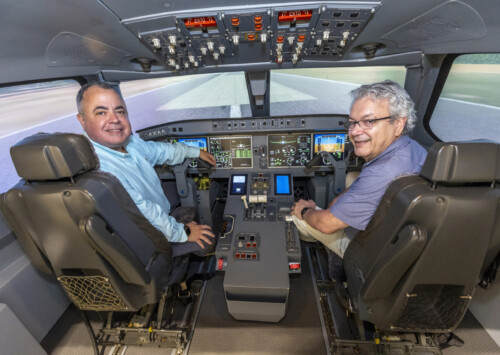Coloured lights on cars enhance cyclist safety: Glasgow University
Amidst the rise of self-driving cars, cyclist safety is a pressing issue and a study by University of Glasgow researchers offers an innovative solution, saying that use of coloured lights on autonomous vehicles could redefine cycle safety on the roads and could shape the future of transportation.
In a press statement, the University of Glasgow says that a ring pulsing coloured lights encircling self-driving cars could be the optimal method for cyclists to discern vehicle movements swiftly.
The study says that the team’s research, spanning several years, merges human-computer interaction specialists and psychologists. Initially, they investigated the nuanced verbal and non-verbal communication between cyclists and human drivers, crucial for determining right of way and averting accidents. Subsequently, collaborating with cyclists, they developed prototype external human-machine interfaces (eHMIs) for self-driving vehicles to streamline road communication.

Volunteers reported that they strongly preferred the simple red and green signals over the more complex emojis or light animations
The researchers explain that in their study, they assessed the effectiveness of three prototype designs by having cyclists interact with cars equipped with eHMIs. Initially, volunteers participated in virtual reality simulations, cycling on stationary bikes while wearing VR headsets. These simulations depicted interactive digital versions of city streets, where they encountered a self-driving Citroen C3 hatchback equipped with one of the three prototype eHMIs.
It adds that one design used a digital screen on top of the car to flash emojis to bike riders, with a happy face to communicate yielding and a grumpy face to communicate the opposite. A second design projected colours onto the road around the car, with green to show the car would yield and red to confirm it would not and a ring of LEDs around the car’s exterior showed lights that bunched up to signal braking and spread apart to show acceleration.
The volunteers reported that they strongly preferred the simple red and green signals over the more complex emojis or light animations, which they felt took more time and effort to understand.
The researchers explain that in the second phase of the study, they enhanced designs for LED strips, rooftop displays, and projectors were implemented on a real Citroen hatchback. At the University’s Garscube campus, a concealed human driver operated the car through simulated traffic scenarios while 20 volunteers biked alongside, observing the eHMIs for cues regarding the car’s intentions. The driver, disguised as a car seat, aimed to heighten the cyclists’ perception of interacting with a genuine self-driving vehicle. Subsequently, cyclists provided feedback on the effectiveness of the eHMI after each cycling session before transitioning to another simulated traffic scenario.
It adds that during this phase of the study, LED lights encircling the car proved more beneficial than simple red or green signals, especially for navigating challenging lane merges and intersections. Additionally, incorporating pulses into the lights strengthened the clarity of the car’s intentions. Across both stages of the study, any form of interface significantly enhanced cyclist confidence and safety compared to no display. Without visual cues, cyclists resorted to guessing vehicle intent from driving behaviour alone, resulting in increased caution, frequent shoulder checks, and heightened stress levels.
“The VR portion of the study helped us to effectively test cyclists’ reactions to the three prototypes in an entirely safe and controlled environment. The results clearly showed that cyclists prefer visual signals which can be understood at a glance they felt that the emojis were too complicated to read without taking their eyes off the road for longer than was comfortable,” says the paper’s corresponding author Ammar Al-Taie, of the University of Glasgow’s School of Computing Science.
“Once we had that feedback, we incorporated the recommendations into improved versions of the three interfaces and set out to test them in the real world,” he adds.
“We are continuing to refine our designs and to expand our understanding of what works best for cyclists. We also want to conduct more research outside the United Kingdom to see how the language of the roads varies in different countries, and how eHMIs might adapt to those differences,” Al-Taie added.
“Taking this study into the real world for the first time gave us really valuable insights into what works for cyclists. It is clear that keeping it simple is the key to effective communication. Bike riders want to be able to stay focused on the road, so lights placed all around the car help them to make immediate decisions about their next move,” says the co-author of the paper Stephen Brewster, who leads the Multimodal Interaction Group at the University of Glasgow.
“This feedback will help us refine future designs, which we hope will be of use to manufacturers to consider integrating into the next generations of self-driving cars. We are also keen to look more at how we can tap into the devices that cyclists often have with them to help keep them safe most bike riders carry phones, for example, so perhaps there is the option to use vibration to communicate with autonomous cars. This is still an evolving area of research but it is important that we do everything we can to ensure the roads of the future are safe for all users,” he adds.
The team’s paper, titled ‘Light it Up: Evaluating Versatile Autonomous Vehicle-Cyclist External Human-Machine Interfaces’, will be presented as a paper at the Association of Computing Machinery CHI conference on Human Factors in Computing Systems next week.












